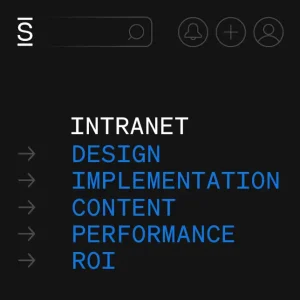Barely anyone is logging in and or engaging with your intranet. And whether you’ve inherited it or designed it, your struggle is significant in terms of its impact on the company. The good news is that you’re not alone. And even better news? We’re going to help you pinpoint what isn’t working and help you fix it.
Although an intranet should make your job easier, many intranets become a dumping ground for outdated content––one that employees loathe navigating.
Let’s explore intranet challenges and offer some innovative and practical tools that will have your internal communications (IC) team acting like air traffic control and your intranet a hub of activity where all intel is timely, useful and intuitive to navigate.

The intranet disconnect
Intranet disconnect is a challenge many companies face. Employees use your intranet to find certain pieces of information. Beyond that, it’s probably not the valuable information hub you would like it to be. So, it’s time to ask some hard questions to improve the situation, and quickly!
- How often are you creating new content for your intranet?
- How often are you evaluating the effectiveness of content on your intranet?
- Are employees consuming content as intended?
- Is there a plan for content creation and consumption, with some pieces mandatory and others relevant to certain roles?
- Are you monitoring readership and engagement stats and assessing the effectiveness of your UI?
- How intuitive is your intranet to new users?
- Are you sharing information that is relevant to employees’ day-to-day work experience?
- How is your intranet impacting your overall employee experience?
Your answers should reveal if your intranet is a hodge-podge of information with hit-or-miss engagement and rating little attention from everyone – including your IC team, versus a cohesive communication network that improves your employee experience (EX) by its mere existence.
Or maybe it’s somewhere in between?
Either way, let’s explore some honest solutions to a few of the most pressing intranet challenges and get you moving in the right direction. We’ll focus on three:
- Robotic attempts at engagement
- Information spammed company-wide
- Over-complicated EX
Robotic attempts at engagement
Training employees is essential, of course––but that work mustn’t end after onboarding. The next step is ensuring they feel like a valued part of your team. And this is a job that never ends.
Authentic employee engagement is hard. And half-hearted attempts at camaraderie are seen as such and have the exact opposite effect. In fact, these attempts can feed the quiet quitting trend that is so popular online right now.
Employee engagement is directly proportional to the strength of the connection an employee feels towards their work as a whole––and it includes everything from their environment and coworker connections to how supported they feel by management.
This engagement strongly correlates with the individual’s commitment to the company. Ask yourself the following:
- Do employees feel they are contributing to, and important in, the bigger picture?
- Are your teams dynamic and encouraging, offering opportunities for individual contributors to shine?
- Is there an energy in your organization, or is everyone struggling through the day (through to payday?)
How do you make your employees feel connected? The simple answer is that you listen to them.
With The Great Resignation, employees have found their voice, and their message is loud and clear—they want to have control over their work life. And the right intranet, with intuitive features, helps them find the balance they desire and the EX that makes work feel less of a chore and more of a choice.
Employee engagement is something every successful company is watching closely. It is an investment with continuous returns, as positive employee experiences transform into profits, productivity, customer satisfaction, and employee retention.
And it begins with offering relevant, personalized information to these individuals.
Relevant information for one part of the company shouldn’t be spammed company-wide

Does someone in Tokyo need to read alerts about shipping delays in Toronto? It could be interesting to know, but it shouldn’t be what’s front and center for this person when they log in to the intranet Monday morning. This is a common intranet challenge.
Information relevant to this employee’s department, location and interests should populate their home screen every time they log in. But this is rarely the case. Irrelevant information is everywhere, and it can overwhelm employees before they even start their day.
You want your team all on the same page, but your rule of thumb should be to keep employees’ communication relevant to the work within their flow.
When everything is important, nothing stands out as important. And when they’re spammed with irrelevant updates all the time, you could unintentionally send your employees down mental rabbit holes, distracting them from the tasks they have at hand. Not only is this taxing to their mental health, it also decreases productivity, and ultimately impacts customer satisfaction and profits. No one is winning here.
Having an intuitive intranet platform that enables personalization for your employees streamlines everything and offers a much cleaner EX, instead of the overcomplicated jumble most are faced with.
An over-complicated EX contributes to turnover
The way employees internalize and interpret their interactions with their organizations matters, as does the context that underlies those interactions. According to Gartner Research, only 13% of employees are fully satisfied with these company experiences.
Is it any wonder why employees are leaving their jobs in the millions per month? The latest Economic News released in August 2022 from the US Bureau of Labor Statistics found that 4.2 million people voluntarily quit their jobs in the previous month. And this number has been consistently within the 4 million range every month so far this year. Employees are stressed and you definitely don’t want your intranet adding to their frustrations.
Leading companies are solving this intranet challenge by focusing on pivoting away from over-complication. They’re asking, “what do employees really need?” And they’re striving to deliver a positive employee experience by focusing intranet content creation around the following:
- Performance. Employees want to feel confident in their work. Having the right tools with clear guidelines for what is expected helps them feel successful in their job.
- Connection. People desire to feel a part of the team. Cultivating a welcoming culture, including embracing and supporting equality and diversity goes a long way in making everyone feel seen and heard.
- Appreciation. Employees want to feel like their work adds value to the company. Recognizing and rewarding good work is crucial, and it should happen publicly at every level.
- Growth. Most people grow bored with their daily tasks. Creating opportunities for growth shows employees they aren’t cogs in your wheel, but crucial team members able to advance and experience success along with the company.
Overcomplicating your intranet is a common challenge and fatal flaw, and one that requires immediate correction. Fortunately, you have options to help you get things back in shape quickly. Reach out for a demo to see how innovative and straightforward your intranet can be, and start creating that ideal employee experience today!

















